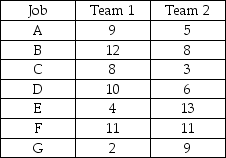Table J.17
A company must take on seven new projects. Each project has a planning stage and a design stage, and the planning stage must be completed before the design stage can begin. Also, two project teams are available to work on these projects: Team 1 works only on planning stages of projects, and Team 2 works only on design stages of projects. The times to complete the project stage, in days, are shown in the following table.

-Using the information in Table J.17 and Johnson's rule, develop a schedule that minimizes makespan for these seven jobs. Assume that job C could be neatly split into two equal parts, each having half of the processing time on each machine as the full job C. Using your original sequence, but splitting job C, what is the reduction in makespan for the seven jobs?
Definitions:
Lack-of-participation Error
A mistake in decision-making processes caused by not involving enough people or the right individuals, leading to less buy-in or missed insights.
Focusing on Symptoms
A mistake in problem-solving where attention is given to the immediate issues rather than addressing the underlying root causes.
Selective Perception
The process by which individuals perceive what they want to in media messages while ignoring opposing viewpoints.
Defining a Problem
The process of identifying and understanding the specifics and boundaries of an issue that needs to be addressed.
Q6: The "Define" step of the Six Sigma
Q21: What is the average flow time for
Q22: Using Figure K.6, what is the best
Q37: Analyze the following decision tree. Determine the
Q73: One form of strategic alliance is the
Q86: A modeler is limited to two or
Q93: Use Scenario 2.6 to solve this riddle.
Q115: Formal work measurement techniques estimate average times
Q169: Increasing the quality level by better products
Q229: _ is the documentation and detailed understanding